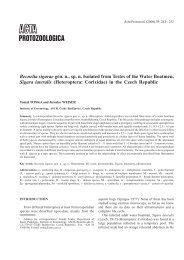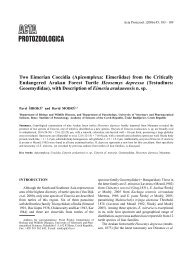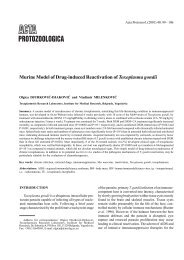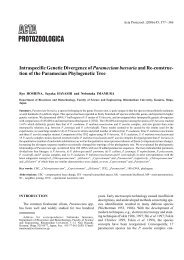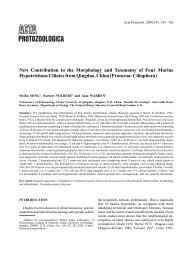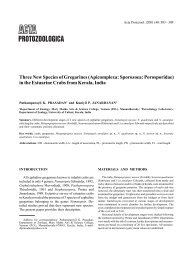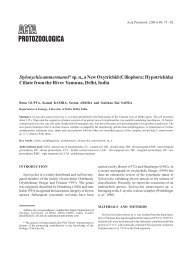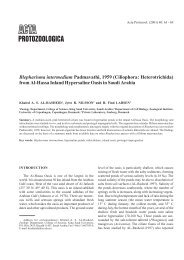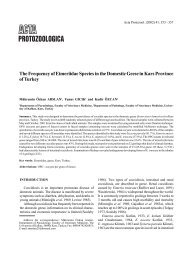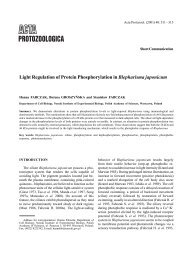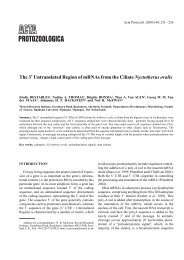Haemosporida of Birds of Prey and Owls from Germany
Haemosporida of Birds of Prey and Owls from Germany
Haemosporida of Birds of Prey and Owls from Germany
Create successful ePaper yourself
Turn your PDF publications into a flip-book with our unique Google optimized e-Paper software.
282 O. Krone et al.<br />
with Haemoproteus sp. Mayer (1911) described<br />
Haemoproteus sp. in 2 <strong>of</strong> 3 tawny owls (Strix aluco)<br />
<strong>from</strong> Lübeck. Information on Leucocytozoon spp. is not<br />
reliable due to possible confusion with Trypanosoma<br />
spp. in the early studies <strong>of</strong> haematozoan research<br />
(Schaudin 1904; Mayer 1910, 1911; Moldovan 1913).<br />
This study considers the prevalence <strong>and</strong> intensity <strong>of</strong><br />
the genera Haemoproteus, Leucocytozoon <strong>and</strong> Plasmodium,<br />
in falconiform <strong>and</strong> strigiform birds <strong>from</strong> <strong>Germany</strong>.<br />
MATERIALS AND METHODS<br />
The birds examined in this study <strong>from</strong> 1996-2000 were wild birds<br />
admitted to rehabilitation centres sampled during the first two days<br />
after admission or birds sampled during ringing. <strong>Birds</strong> originated <strong>from</strong><br />
mainly three different locations in <strong>Germany</strong>: Baden-Württemberg<br />
(BW) (47°50’ to 49°25’ N, 8°50’ to 9°75’ E), Lower Saxony (LS)<br />
(52°00’ to 53°00’ N, 9°50’ to 11°00’ E) <strong>and</strong> Berlin-Br<strong>and</strong>enburg<br />
(BB) (52°00’ to 53°25’ N, 11°50’ to 14°50’ E). Twenty-five different<br />
species <strong>of</strong> raptors in 5 families were subject to this study (Table 2).<br />
Identification <strong>of</strong> the bird species <strong>and</strong> the age categories was based on<br />
the descriptions by Baker (1993), Forsman (1999) <strong>and</strong> Glutz von<br />
Blotzheim (1971). The ageing <strong>of</strong> the pulli was performed by using the<br />
descriptions <strong>of</strong> Heinroth <strong>and</strong> Heinroth (1927) <strong>and</strong> the tables <strong>of</strong><br />
growth for the falconiformes (Bijlsma 1997). A total <strong>of</strong> 976 blood<br />
smears <strong>from</strong> falconiform <strong>and</strong> 173 <strong>from</strong> strigiform birds were examined<br />
for the presence <strong>of</strong> blood parasites.<br />
Samples were taken <strong>from</strong> the brachial vein. Blood films were air<br />
dried, fixed in absolute methanol <strong>and</strong> stained with Giemsa´s solution<br />
for 40 minutes. The scanning time was 10 min for every blood smear<br />
examined. They were scanned at x25 for 0.5 min, x100 for 1,5 min,<br />
x200 for 2 min, <strong>and</strong> x400 for 6 min. The oil immersion (x1000) was<br />
only used when the blood smear contained parasites. Measurements<br />
were performed with a Zeiss Axioplan microscope attached via a<br />
video camera to a PC with AnalysisPro 2.1 as s<strong>of</strong>tware. Intensities <strong>of</strong><br />
parasites were calculated by counting them in fields <strong>of</strong> 300-400<br />
erythrocytes in 10 fields.<br />
Species identification was based on the descriptions by Peirce et<br />
al. (1990) for Haemoproteus brachiatus, H. tinnunculi, H. elani <strong>and</strong><br />
H. nisis, but for H. buteonis by Valkiûnas (1997), <strong>and</strong> by Bishop <strong>and</strong><br />
Bennett (1989) <strong>of</strong> strigiform birds; for Leucocytozoon <strong>of</strong> Falconiformes<br />
by Greiner <strong>and</strong> Kocan (1977) <strong>and</strong> <strong>of</strong> Strigiformes by Bennett et al.<br />
(1993), for Plasmodium by Garnham (1966). Trypanosoma avium<br />
<strong>from</strong> the pygmy owl (Glaucidium passerinum) was described previously<br />
by Krone (1996).<br />
The age (three classes: nestling, immature bird, adult bird), sex,<br />
origin (seven regions), order (Falconiformes or Strigiformes), bird<br />
species (25 species), <strong>and</strong> a possible injury or disease (birds admitted<br />
to rehabilitation centres) were regarded as variables potentially influencing<br />
its parasite burden (two categories: infected/not infected).<br />
Logistic regression (Hosmer <strong>and</strong> Lemeshow 1989) was used in order<br />
to analyse the effect <strong>of</strong> multiple variables on the parasite load.<br />
Categorical variables were compared by means <strong>of</strong> chi-square test or<br />
Fisher’s exact test. Adjusted st<strong>and</strong>ardised residuals were used to<br />
identify the categories responsible for a significant chi-square test<br />
(Everitt 1977). St<strong>and</strong>ardised residuals beyond ± 1.96 indicate a significant<br />
deviation <strong>from</strong> the expected values. The McNemar test<br />
(Bortz et al. 1990) served to compare prevalences for samples with<br />
related parasite information. A potential trend for the prevalences <strong>of</strong><br />
the age classes was tested using Pfanzagl’s trend test (Bortz et al.<br />
1990). The significance level was generally set to α = 0.05. All<br />
statistical calculations were performed using the SPSS 9.0 s<strong>of</strong>tware.<br />
RESULTS<br />
A total <strong>of</strong> 11% (n=1149; 95% CI: 10, 13) <strong>of</strong> blood<br />
smears <strong>from</strong> birds <strong>of</strong> prey were positive for haematozoa.<br />
A similar prevalence was found in Falconiformes<br />
(n=976, 11%; 9, 13) <strong>and</strong> Strigiformes (n=173, 13%;<br />
8, 19). The nestlings (pulli) had the lowest, whereas adult<br />
birds had the highest prevalences.<br />
Of 17 hawk species examined, 9 were found to be<br />
infected with haemoparasites (Table 1). In comparison<br />
only 3 <strong>of</strong> 8 owl species examined were infected<br />
(Table 2).<br />
No haematozoa were found in the osprey (P<strong>and</strong>ion<br />
haliaetus, pulli n=40, immature n=5, adult n=28), honey<br />
buzzard (Pernis apivorus, n=13), black kite (Milvus<br />
migrans, n=11), marsh harrier (Circus aeruginosus,<br />
pulli n=16, immature n=6, adult n=4), hen harrier (Circus<br />
cyaneus, n=1), montagu´s harrier (Circus pygargus,<br />
pulli n=31), merlin (Falco columbarius, n=1) <strong>and</strong> peregrine<br />
falcon (Falco peregrinus, pulli n=36, immature<br />
n=1, adult n=7).<br />
No blood parasites were found in the barn owl (Tyto<br />
alba, pulli n=25, immature n=6, adult n=31), Tengmalm´s<br />
owl (Aegolius funereus, n=1), short-eared owl (Asio<br />
flammeus, n=1), little owl (Athene noctua, n=1) <strong>and</strong><br />
eagle owl (Bubo bubo, n=8).<br />
The hawks were mainly infected with Leucocytozoon<br />
toddi (9.5%, n=976) <strong>and</strong> only a few with Haemoproteus<br />
spp. (1.9%, n=976) while an equal number <strong>of</strong> owls<br />
were infected with L. ziemanni (10.4%, n=173) <strong>and</strong><br />
H. syrnii (9.2%, n=173). Plasmodium fallax <strong>and</strong><br />
Trypanosoma avium were only detected in the single<br />
pygmy owl examined. Measurements <strong>of</strong> the blood parasites<br />
are presented <strong>from</strong> infected birds in which large<br />
numbers <strong>of</strong> haemoparasites were found (Table 3).<br />
A logistic regression was performed using the age,<br />
order, origin, season, <strong>and</strong> the admission to a rehabilitation<br />
centre as independent <strong>and</strong> the infection state as dependent<br />
variable. The sex was known only for 547 out <strong>of</strong><br />
1149 birds. Therefore, the influence <strong>of</strong> sex was separately<br />
tested, in order to use the full data set in the



